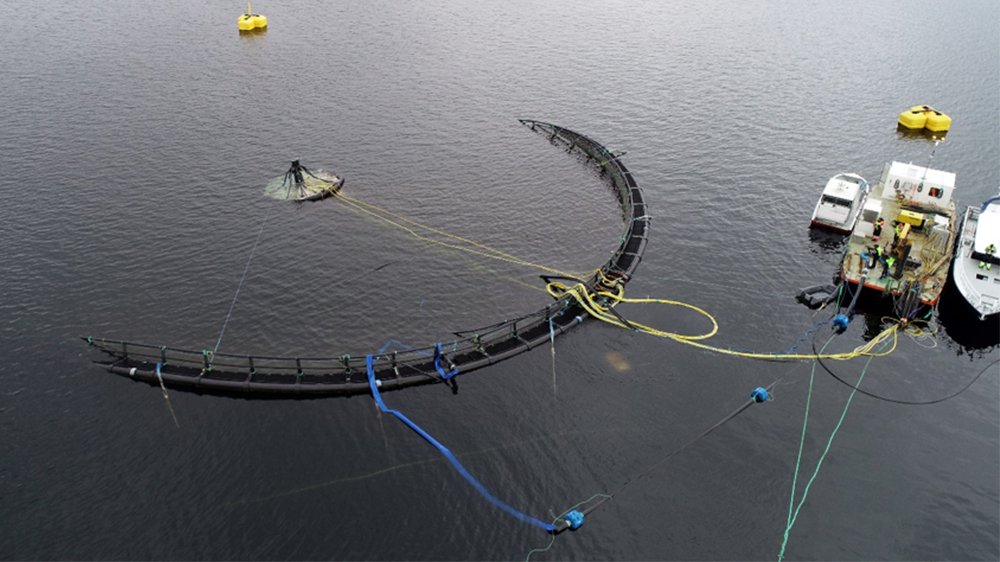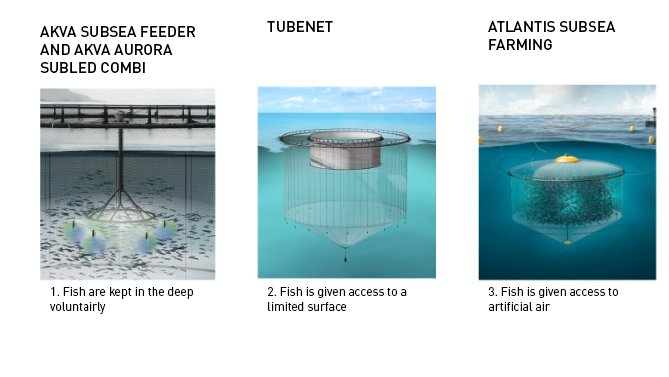
In May 2019, the first fish were deployed in Atlantis Subsea Farming's submersible pen, and an exciting test period kicked off.
Atlantis is an essential part of AKVA group’s strategy to investigate different concepts to keep the biomass low in the water column. In Atlantis, fish is kept down at 25-40 meters depth in a submersible pen where the salmon have access to air via an underwater air dome. The companies behind Atlantis Subsea Farming are AKVA group, SinkabergHansen and Egersund Net, and the collaboration started in 2014.
I am happy to say that we reached a significant milestone in the project in May 2019 when fish was transferred from an ordinary pen to Atlantis. We have great faith that this may be a solution in specific locations with rough conditions at the surface. We have over time developed a lot of experience in keeping the fish deep by various solutions, like for instance, combining deep feeding and appropriate lighting, or through the use of tubenet.
Research carried out by e.g., the Institute of Marine Research shows that the salmon lice reside in the upper layers of the water, above 10-15 meters.That is the substantial reason for us to develop methods for deep operations.
Read about how tubenet reduced lice infestation with more than 80%.
Large-scale testing
Atlantis Subsea Farming was granted a development license in March 2018, allowing to test the concept on fish at large-scale. Focus has been on design, construction, and technological testing in 2018 and 2019. Now the fish behavior and growth will tell us whether the concept provides a productive and healthy production environment or not. If the project succeeds with salmon, the concept is easily transferable to other species.
We have faced a few challenges during the project. One of them is to try to make the underwater air dome stable within what I would call an “unstable” system. The development license allows us to test the technology on actual biomass for three generations – and this is essential for the project.
Normal fish behavior
Transferring fish from an ordinary pen to Atlantis in May was a thoroughly planned operation, and the main focus was to stress the fish as little as possible.
The fish was deloused with a mechanical method three weeks before transfer. Cameras and ROV, as well as the sensors linked with the infrastructure, provided valuable information while submerging Atlantis down to 25-30 meters below the surface.
Submerging the pen took about 30 minutes. The fish was a little uncomfortable in the middle of the process, but it calmed down and picked up a regular swimming pattern a few minutes after the pen had stabilized. The fish started to show interest in the feed the next day.
The results we have seen so far are promising. Daily monitoring shows normal swimming speed, which indicates that the fish fills its swim bladder in the air-dome as planned. Feeding rate and feeding behavior are healthy, and there has hardly been any mortality.
Through six cameras covering all the depths in the cage, highly qualified experts from SinkabergHansen observe the fish every day. So far, they have seen nothing but normal activity and behavior.
The technology
The first version of the submersible pen is now product-certified for this particular site. Submersible pens may in principle be moored with regular frame moorings, and the circumference of the pen is 160m. The plastic pen is filled with water before being submerged and then filled with air when the pen is raised. The AKVAconnect control system enables remote control of the entire process from a barge or onshore, with dedicated software programmed for this system.
The dome connected to the middle of the net-roof grants access to air for the fish. The waterborne feeding system, lights (AKVA Aurora SubLed) and cameras are also connected to the dome.
AKVA group has gained experience with waterborne feeding in the Atlantis project. This knowledge is indeed valuable to us when we now step up the development of a waterborne feeding system in combination with flexible feeding. In Atlantis, the waterborne feeding makes it possible to feed with a safe and steady spreading pattern at 25-30 meters depth.
All in all, we consider the investments legitimate to the operational benefits we expect Atlantis to provide.
The concept of deep operation
- Deep feeding and lights keep the fish voluntarily at lower depths
- A Tubenet provides the fish access to a limited surface
- Fish is kept down in a submersible cage with access to artificial air
Concept no 1. and 2. are in the market, and Atlantis is still an innovation project. AKVA group is working continuously to improve the different concepts.

Crucial in all three deep operation concepts is to understand the biology and how the fish react on environmental changes and how the technology interacts with the biomass. There are also considerable challenges in developing solid operational practices and solutions. That's why we invest in projects that might give us valuable answers and documentation about production efficiency, fish welfare, and other aspects vital to the success of our customers.
{{cta('70bb0e5a-5714-4210-ad5c-b999ba24c186')}}